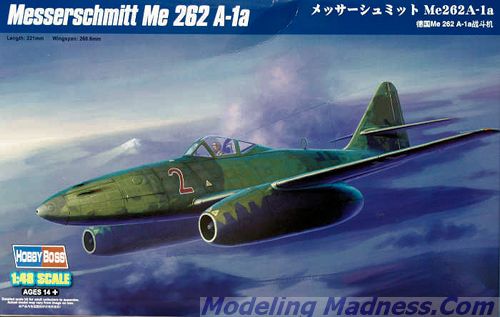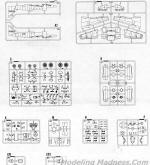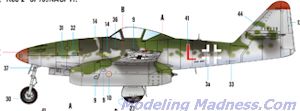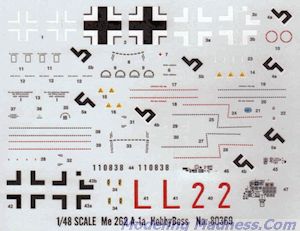
Hobby Boss 1/48 Me-262A-1a
| KIT #: | 80369 |
| PRICE: | $32.00 MSRP |
| DECALS: | Two options |
| REVIEWER: | Scott Van Aken |
| NOTES: | 2013 release |

The Messerschmitt Me 262 Schwalbe (English: "Swallow") of Nazi Germany was the world's first operational jet-powered fighter aircraft. Design work started before World War II began, but engine problems and top-level interference kept the aircraft from operational status with the Luftwaffe until mid-1944. Compared with Allied fighters of its day, including the British jet-powered Gloster Meteor, it was much faster and better armed. One of the most advanced aviation designs in operational use during World War II, the Me 262 was used in a variety of roles, including light bomber, reconnaissance, and even experimental night fighter versions.
Me 262 pilots claimed a total of 542 Allied kills, although higher claims are sometimes made. The Allies countered its potential effectiveness in the air by attacking the aircraft on the ground and during takeoff and landing. Engine reliability problems—from the pioneering nature of its Junkers Jumo 004 axial-flow turbojet engines, the first ones ever placed in mass production—and attacks by Allied forces on fuel supplies during the deteriorating late-war situation also reduced the effectiveness of the aircraft as a fighting force. In the end, the Me 262 had a negligible impact on the course of the war as a result of its late introduction and the consequently small numbers put in operational service.
The Me 262 was often mistaken by observers for the Gloster Meteor, the first Allied jet fighter aircraft, due to similarities in their appearance, leading to numerous friendly fire incidents on both sides. While German use of the aircraft ended with the close of the Second World War, a small number were operated by the Czechoslovak Air Force until 1951. Captured Me 262 were studied and flight tested by the major powers, and ultimately influenced the designs of a number of post-war aircraft such as the North American F-86 Sabre and Boeing B-47 Stratojet. number of aircraft have survived on static display in museums, and there have also been several privately built flying reproductions.
| THE KIT |
 This
is at least the fourth 262 kit produced by Hobby Boss. In what seems to be a
standard marketing for multiple variant kits, they started off with some
one-offs and less produced variants before finally reaching the major version,
the standard fighter. Of the nine sprues, most of them are common to the other
versions in that they are the flying surfaces, engines, landing gear and cockpit
bits. New sprues to this build are for the guns and the fuselage halves and the
nose section.
This
is at least the fourth 262 kit produced by Hobby Boss. In what seems to be a
standard marketing for multiple variant kits, they started off with some
one-offs and less produced variants before finally reaching the major version,
the standard fighter. Of the nine sprues, most of them are common to the other
versions in that they are the flying surfaces, engines, landing gear and cockpit
bits. New sprues to this build are for the guns and the fuselage halves and the
nose section.
The cockpit is quite nicely done with a lot of detail that includes seat, rudder pedals, control stick and instrument panel with side consoles. There is raised decal on the latter items and a decal is also provided. The cockpit assembly is a proper tub with detail on the underside, just like in the real aircraft. The new nose consists of a metal nose gear well on which the gun bay is built. Not only the 30mm cannon, but also their feed belts are provided. Into this assembly fits the nose gear leg which comes with an oleo scissor (not all did) and a choice of smooth or ribbed nose wheel.
These two assemblies are to fit into the fuselage halves along with a lot of other detail that includes radio racks, oxygen bottles and other bits. This is all visible through a small removeable panel. Those wishing to glue the panel closed can leave out all these bits. The tailplanes are a single piece on each side and there is a separate rudder. The gun bay doors can be posed open if one wishes. There is a three piece canopy set with the windscreen piece including the surrounding fuselage. The canopy is designed to be built open.
The main gear well is not boxed in as on the real plane it is open. There is, however, a forward and central framework that gets installed into the lower wing. The upper wing sections are in a right and left half. Though the engine nacelles have interior framing, there are no full engines, the kit supplying intake and exhaust sections. Main landing gear are well done with diamond block main tires. There are separate panels to fit on the underside of the nose section. I would imagine that when the fighter bomber variant is kitted, that these panels will have the bomb racks. Rocket take off units are provided, but were not used very often.

 Instructions
are quite well done with clear construction steps. Color information is provided
via a number of manufacturers as well as RLM numbers. The two options are both
in RLM 82/75/76 with the box art plane, red 2, being attached to 10./NAGr 11.
The other option, red L was attached to I/KG 51. One would expect bomb racks on
red L, but there you have it. The decal sheet is nicely done with all the
appropriate stencil markings and also includes split swastikas.
Instructions
are quite well done with clear construction steps. Color information is provided
via a number of manufacturers as well as RLM numbers. The two options are both
in RLM 82/75/76 with the box art plane, red 2, being attached to 10./NAGr 11.
The other option, red L was attached to I/KG 51. One would expect bomb racks on
red L, but there you have it. The decal sheet is nicely done with all the
appropriate stencil markings and also includes split swastikas.
| CONCLUSIONS |
The 262 is a very popular subject in 1/48 scale with nice kits being produced by Monogram, Dragon, Tamiya, Pegasus and even Lindberg did a fair example. This one looks to be right up there with the best of them and I'm betting that it will make into a fine model. Those wanting something a bit different from the kit offering will find quite a few aftermarket sheets for this one.
| REFERENCES |
http://en.wikipedia.org/wiki/Me-262
Me-262 volume Two, J. Richard Smith and Eddie Creek, Classic Books, 1998, ISBN 0-9526867-3-2
July 2014
Thanks to Squadron Products for the preview kit. Get yours today at your local shop or on-line retailer.
If you would like your product reviewed fairly and quickly, please contact me or see other details in the Note to Contributors.